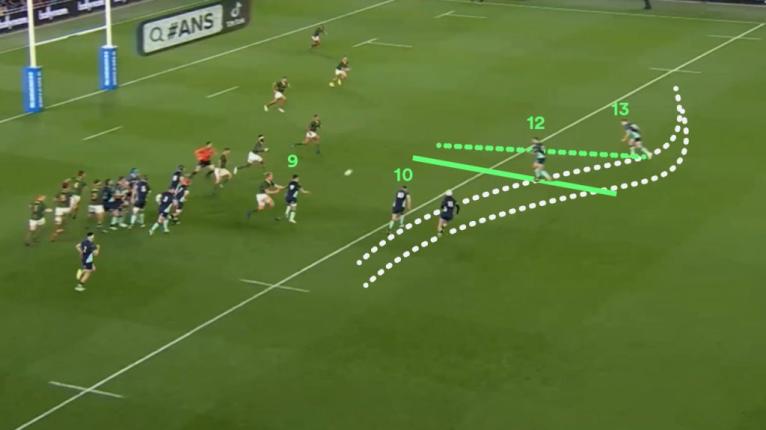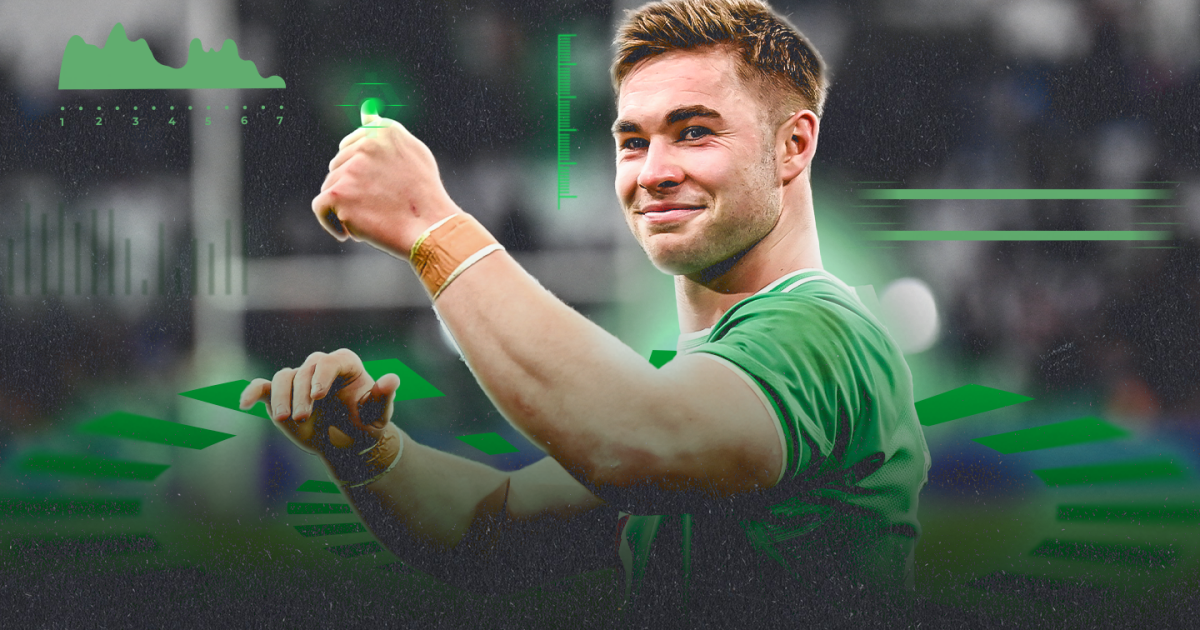With the talismanic Johnny Sexton retired, there was fear and anxiety about what the future looked like for Ireland, and how their attack would function without their inspirational leader and fly-half.
In 80 sizzling minutes inside the Stade Velodrome cauldron, Jack Crowley quelled those concerns, driving his country to an emphatic 38-17 triumph. A record win for Ireland over France, and a stupendous way to raise the curtain on their Six Nations title defence.
The 24-year-old assumed the starting No 10 role in his eighth Test and piloted Ireland’s attack with enough poise to promise the post-Sexton era will arrive with minimal turbulence.
Crowley wasn’t perfect – he had a few kicking errors and finished with three turnovers conceded – but it was his attacking touches within Ireland’s game plan which impressed the most.
Inexperienced Test fly-halves rarely have the courage to play flat and challenge the line, but Crowley was an exception when offered the opportunity. He showed natural ball-playing ability which mirrored the icon he has replaced.
The set-piece attack was typical of Ireland’s play and gave Crowley a back seat during the early exchanges.
The fly-half ran the sweep lines out behind the ball-carriers in the midfield so often plotted by Sexton in the past. Below is an example from of a similar play design against South Africa in 2022.

On the first strike play against France, Ireland targeted outside centre Gael Fickou using the midfielders as distributors allowing Crowley to watch from the back.
On the second launch, Crowley played a distributor role looking to move the ball wide on first phase.
On the third, the midfielders finally began playing out the back to get Crowley involved as a playmaker.
Ireland took their quest to create extra numbers to the extreme by using a short lineout and playing number eight Caelan Doris at 10. Jamison Gibson-Park (nine) ran a wider arc to add more width.
Bundee Aki (12) anchored the play as the direct runner and first ball player.
What unfolded was a double screen off Aki, with Josh van der Flier (seven) as the first decoy and Robbie Henshaw (13) as the second, with Crowley injected as the second ball-player.



Crowley (10) had plenty time and space once he received the ball with France playing non-committal drift.
He squared up the nearest defender and offered a late touch at the line, getting whacked in the process by Jonathan Danty.
James Lowe (11) ended up taking the carry.


Although the play didn’t rip France open, it showed Crowley’s willingness to engage the defence with ball in hand.
Taking late hits is part of the job description and even a necessity in order to manipulate men and create space. There are many distributors but few playmakers. Crowley showed he is going to be the latter.
Although the play didn’t break the gain line, France’s edge defence was decimated. Ireland needed just one more phase to capitalise and their speed around the corner gave them the opportunity.

Gibson-Park (nine) fired a miss-pass to Henshaw (13), who played Aki (12) into the remaining space with deft hands.


Ireland’s hulking centre punched through multiple defenders before offloading inside to Gibson-Park for the opening try.
The opportunity came from everyone doing their job, including Crowley, and Aki producing a bit of magic to capitalise.
While Crowley’s involvement as a ball player came from a pre-planned play above, his next came from a heads-up moment in transition after Ireland regathered possession following a chargedown.

France’s defensive line was scrambling and offered large space out to their right. The young 10 worked back into position to orchestrate the next phase.

France were short of numbers from Danty outward, with large gaps between each of the outside backs.
Having already discerned Danty would bite when engaged from the previous play, Crowley sized the situation up and opted to play Aki into the hole outside him.


Aki was guaranteed to burst through the line had he held the pass. Ireland appealed for a knock-on from the hand of Danty however it appeared Aki dropped the ball off his back hip.
The decision from Crowley was correct, highlighting his ability to assess a situation quickly and make a good read in an unstructured situation.
However, Crowley’s play of the night came from a set-piece launch around midfield.
On the first phase Ireland crashed into the midfield with Crowley instrumental in generating a positive gainline play.

They ran a tight formation with Crowley having the option of Aki short or his blindside winger Calvin Nash (14) out the back, also on a short pass.
This time Danty (12) was one defender outside Crowley, Gregory Alldritt (number) marked the fly-half.
Danty sat back on his heels to make the read on Aki or Nash, which allowed Nash to win gainline with a strong carry.


Ireland rolled down the field successfully on this possession pushing France backwards towards their 22.
On the 10th phase Crowley eventually got the same setup with Danty defending the runner outside him, Tadhg Beirne, and delivered a stroke of genius.

The initial setup was just as important as the final play in the passage. Danty had been shown the back-door pass moments before, but this time Crowley changed it up and hit the flat runner with a slight head-fake.
Crowley showed Danty a picture and then feigned that same picture a second time in a crafty piece of trickery. Ireland doubled down on two back-door runners just to sell it even more.

Danty looked to have made the right read, leaning towards Beirne, but there was enough hesitation for Ireland to exploit.
Something about Crowley’s motion and the animation by Lowe and Henshaw sold the ruse, leaving Danty caught between two places.




Beirne’s breakaway put Ireland 17-3 up before the second yellow card offence by Paul Willemse.
Once France were reduced to 14, Ireland weren’t going to be troubled. They were already far superior when it was 15 on 15.
Crowley played more of a distributor role in the second half and wasn’t required to fire any shots, but still showed flashes of class.
He turned a one-handed recovery of a bouncing ball into a snap kick end-over-end showing a high level of skill. He feigned a crossfield kick motion, reloaded, and fired off a pass for his runner. On a kick return he faked out a defender by pulling back a pass only to throw it behind the defender’s back.
Crowley’s time on the ball is special. He seems to have more of it than everyone else and so can make late decisions once the defence has been thrown out of kilter. At Test level that is a luxury.
Vision, late anticipation, fast feet and hands and a bag full of skills to play with. Crowley seems to have all the tools.
He isn’t shy of playing direct and taking contact which is the perfect fit for Ireland’s style of play. They need their 10 to be a creator as Sexton was, relying on timing and precise running lines within the scheme.
Crowley is unlikely to end up with a load of eye-catching stats. It will be line break assists and try assists which show his true worth.
Even still, the Munster pivot beat three defenders and had one line break in addition to his assist for Beirne. He nailed all five of his conversions and added a penalty for 13 points off the tee.
Inevitably, Crowley will make costly errors. But he has the ability to create big plays which negate the mistakes, as it was in his first opportunity to start a big game for Ireland.
Sage is the Official Insights Partner of the Guinness Six Nations, enhancing the fan, player and coach experience through innovative new technology and enhanced insights to the game. Find out how Sage can support your business at sage.com and discover more rugby insights at sage.com/rugby.





























